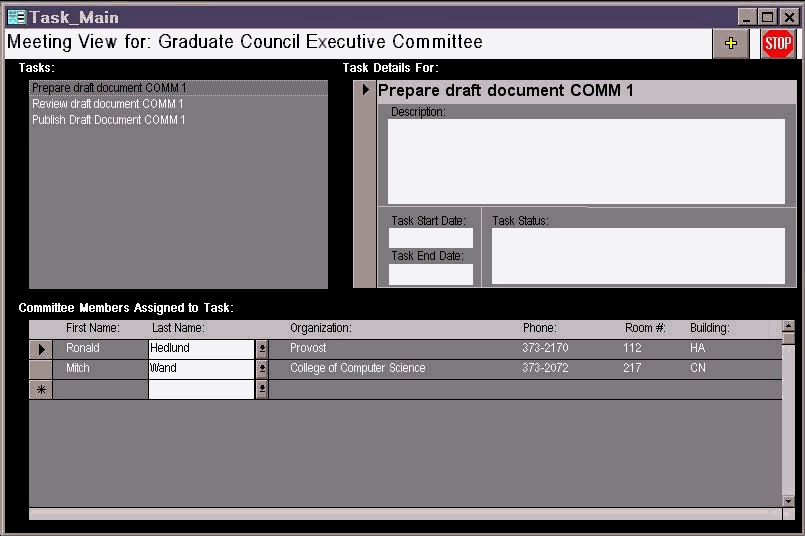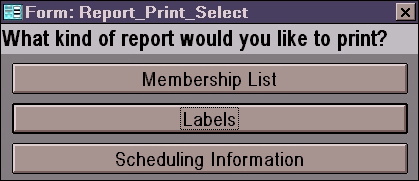

This document describes in detail the functional requirements of the Committee Information Tracking System (CTS). CTS is a software project of the Office of the Vice Provost for Research and Graduate Education and Administrative Computer Services intended to facilitate the management of information related to university committees.
The sections below describe CTS's Functional Specifications by listing and describing all screens and functions available within each screen.
There are six screens in CTS. This section uses samples of these screens to document CTS’ functionality. The sample screens were produced using the Win95 interface and look slightly different under Windows 3.1 There is a one-to-one correspondence between CTS screens and the functional areas planned for the first release of CTS.
Most CTS screens present information using a 3-pane style. The first pane, on the top left of the screen, gives a list of item names, e.g. committee names. The second pane, on the top right of the screen, gives detail about the item selected (highlighted) on the first pane, e.g. detail information about a committee. The third pane, on the bottom of the screen, gives a list of records related to the item selected (highlighted) on the first pane, e.g. a list a committee members. CTS gives a brief description, at the bottom of the screen, of the currently selected field when the cursor is on the second or third panes.
CTS as a Windows 3.1 application responds to standard commands such as:
TAB - used to move from one control to the next
ESC - used to cancel the last data change
Ctrl-F4 - closes the current screen
Alt-F4 - closes the current application
Del - deletes the currently selected record. In CTS the selected record is denoted by using the "record selector", which is a highlighted bar with a right-pointing triangle to the left of where the record is displayed. The record selector automatically turns into a "pencil icon" when changes to data are detected.
This is CTS’ opening screen, shown in Figure 1, and it
provides several controls for maintaining committee information such as
committee name, type, sponsor information, membership list, etc.
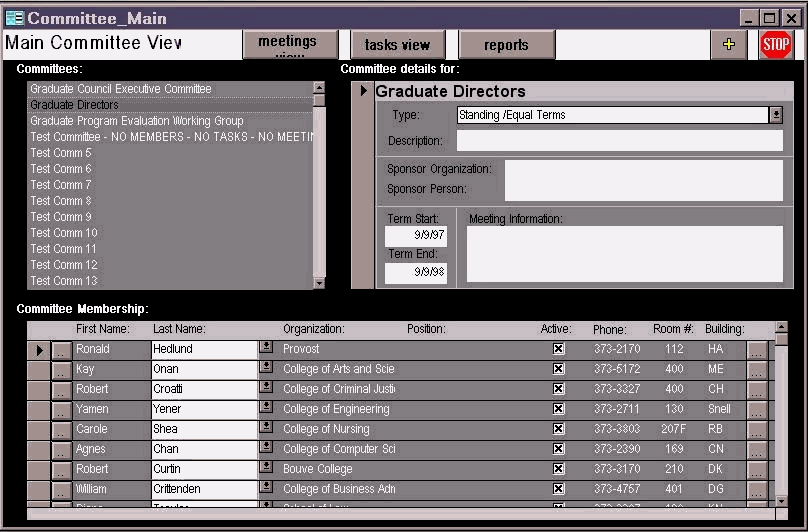
The following functionality is provided on this screen:
Meetings View By clicking on this control the user tells CTS to display the "Meetings View" screen for the committee currently highlighted on the committees list (see section 2.4 below).
Tasks View By clicking on this control the user tells CTS to display the "Tasks View" screen for the committee currently highlighted on the committees list (see section 2.5 below).
Reports By clicking on this control the user tells CTS to display the "Report Selection" screen. Reports are generated for the committee currently highlighted on the committees list (see section 2.6 below).
+ By clicking on this control the user tells CTS to ad a new committee record. CTS automatically positions the editing cursor on the committee name field ready for entering the name of the new committee.
STOP By clicking on this control the user exits CTS.
This is the pane at the top left on the screen and it contains a list of committee names. Note that there may be a scroll bar (as in Figure 1) on the right of this pane to indicate that there are more items in the list below the last one shown. The arrows and the handle in the scroll bar can be used to scroll to the remaining items.
By default, the first item in the list is selected and the corresponding detailed information is displayed on the pane on the top right of the screen. Other committees can be selected by clicking on their name on the list or by highlighting it using the keyboard arrow keys.
This pane is at the top right of the screen and contains all the information fields describing the currently highlighted committee on the left pane. The "Type" field in this pane is a drop-down list containing valid committee types. The list of types is displayed by clicking on the arrow control at the end of the field. The user selects a type by clicking on it or by typing its first letter. All fields in this pane respond to standard Windows editing commands.
This pane is at the bottom of the screen and contains contact information for each member of the currently selected committee. This pane is also used to add new members to the selected committee. This is done by clicking on the handle (down arrow) for the last item in the list (i.e., blank name) and clicking on the desired person name from the list displayed. This procedure can also be used to replace an exiting member with a new one. CTS automatically prevents the user from adding repeated or invalid names to the membership list.
The only field that can be edited on this pane is the "Active" field to indicate whether the person is currently attending meetings of the selected committee. Note that there may be a scroll bar (as in Figure 1) on the right of this pane to indicate that there are more members in the list below the last one shown. The arrows and the handle in the scroll bar can be used to display the remaining members.
This is CTS’ screen for managing "Person" information and is shown in Figure 2. This screen provides several controls for maintaining information such as NEU ID, name, addresses, etc. The information shown in this screen is captured automatically from NEU’s HRM records.
+ By clicking on this control the user tells CTS to ad a new person record.
STOP By clicking on this control the user exits CTS.
This screen contains two panes. This first pane, occupying the top half of the screen is the Person Detail pane. All fields in this pane respond to standard Windows editing commands. CTS gives a brief description, at the bottom of the screen, of the currently selected field.
The top pane contains a field used to record "Scheduling Notes" needed when scheduling meetings. This field is not visible by default (see Figure 3), but it can be accessed by using the horizontal scroll bat at the bottom of the screen. Scrolling to the right displays this field as shown in Figure 3. The top pane also contains the "Check Sched. Notes" field (a check-box ) that is displayed in this and other CTS screens to indicate that there is information in the "Scheduling Notes" field. The "Check Sched. Notes" field has to be manually updated by the user.
The bottom half of this screen contains a pane that lists
all the committees the current person is a member of. The "Active" field
can also be edited in this pane. Each committee record in this pane has
one "Detail" • • • button that provides access to membership data as described
in section 2.3 below. Membership in additional committees can be specified
using this pane by selecting a new committee name in the drop down list
for committee names. This is done by clicking on the handle (down arrow)
for the last item in the list (i.e., blank committee name) and clicking
on the desired committee name from the list displayed. This procedure can
also be used to replace an exiting membership record with a new one. CTS
automatically prevents duplicate membership assignments.
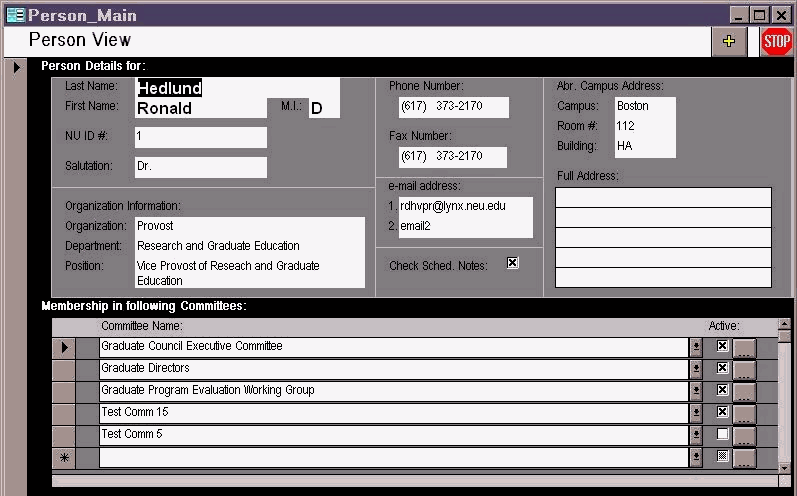
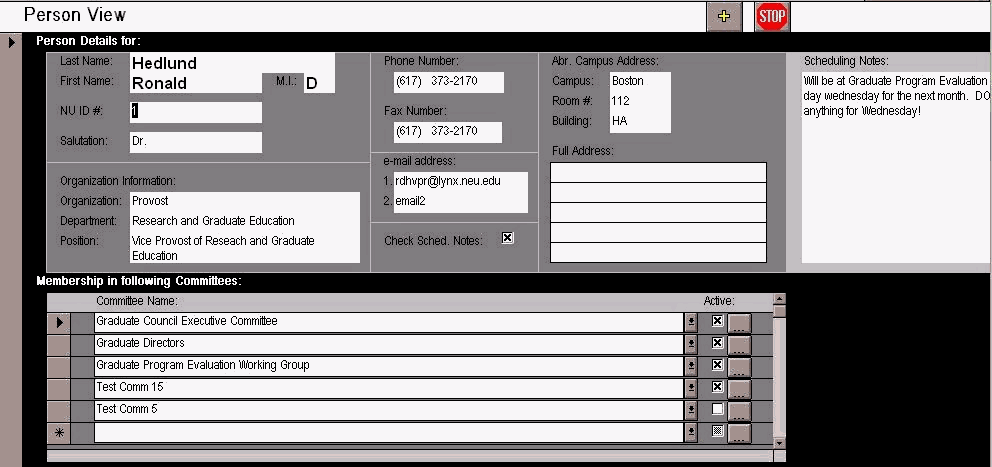

Figure 4 shows the "Person Membership Details" screen used by CTS to track and maintain committee-member record information such as position within the committee, status, membership term, etc. The "Membership Type" field in this screen is a scroll list containing valid membership types. The list of types is traversed by clicking on the arrows at the end of the field. The user selects a type by clicking on it or by typing its first letter. All fields in this pane respond to standard Windows editing commands.
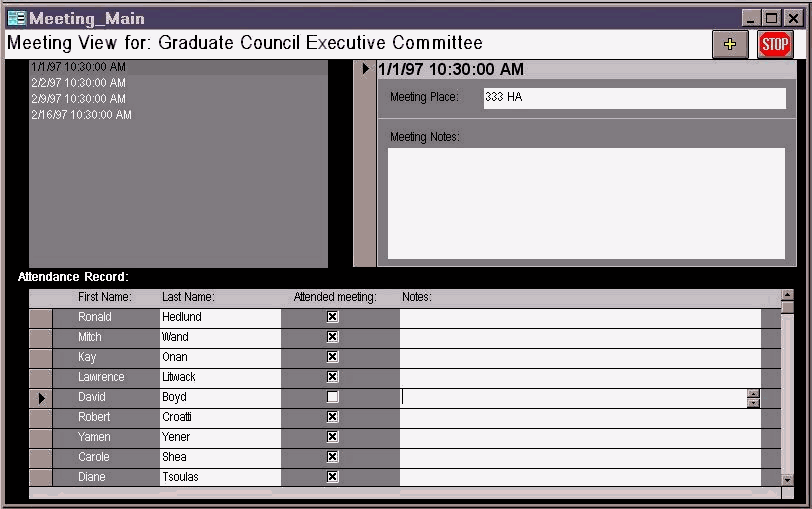
This is CTS’ screen for managing "Meeting" information and is shown in Figure 5. For each committee meeting, this screen provides information such as date, time, place, attendance, etc.
The following functionality is provided on this screen:
+ By clicking on this control the user tells CTS to add a new meeting record. CTS automatically positions the editing cursor on the meeting date field ready for entering the new meeting date and time.
STOP By clicking on this control the user exits CTS.
This is the pane at the top left on the screen and it contains a list of meeting dates and times for the selected committee and is shown in Figure 5. Note that there may be a scroll bar on the right of this pane to indicate that there are more items in the list below the last one shown. The arrows and the handle in the scroll bar can be used to scroll to the remaining items.
By default, the first item in the list is selected and the corresponding detailed information is displayed on the pane on the top right of the screen. Other meeting records can be selected by clicking or highlighting them using the keyboard arrow keys.
This pane is at the top right of the screen and contains all the information fields describing the currently highlighted meeting record on the left pane. All fields in this pane respond to standard Windows editing commands.
This is CTS’ screen for managing "Task" information and is shown in Figure 6. For each committee task, this screen provides information such as
task description, dates, members assigned, etc.
The following functionality is provided on this screen:
+ By clicking on this control the user tells CTS to ad a new task record for the selected committee. CTS automatically positions the editing cursor on the task name field ready for entering the name of the new task.
STOP By clicking on this control the user exits CTS.
This is the pane at the top left on the screen and it contains a list of committee tasks. Note that there may be a scroll bar on the right of this pane to indicate that there are more items in the list below the last one shown. The arrows and the handle in the scroll bar can be used to scroll to the remaining items.
By default, the first item in the list is selected and the corresponding detailed information is displayed on the pane on the top right of the screen. Other tasks can be selected by clicking on their name on the list or by highlighting it using the keyboard arrow keys.
This pane is at the top right of the screen and contains all the information fields describing the currently highlighted task on the left pane. All fields in this pane respond to standard Windows editing commands.
The only field that can be edited on this pane is the
"Active" field to indicate whether the person is currently attending meetings
of the selected committee. Note that there may be a scroll bar (as in Figure
6) on the right of this pane to indicate that there are more members task
assignments in the list below the last one shown. The arrows and the handle
in the scroll bar can be used to display the remaining task assingments.
